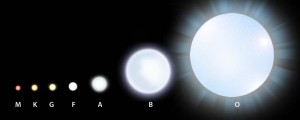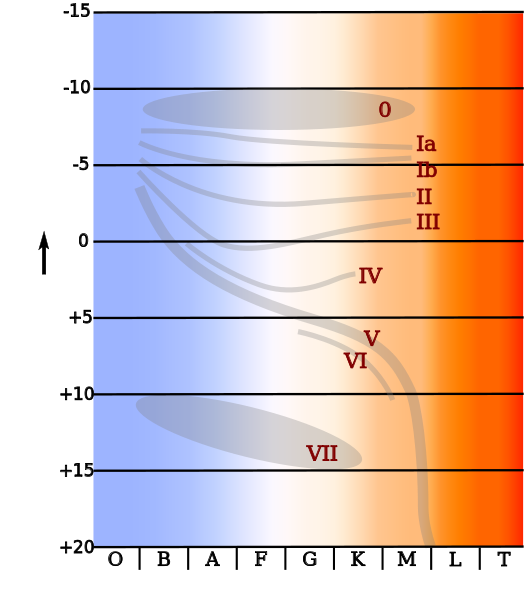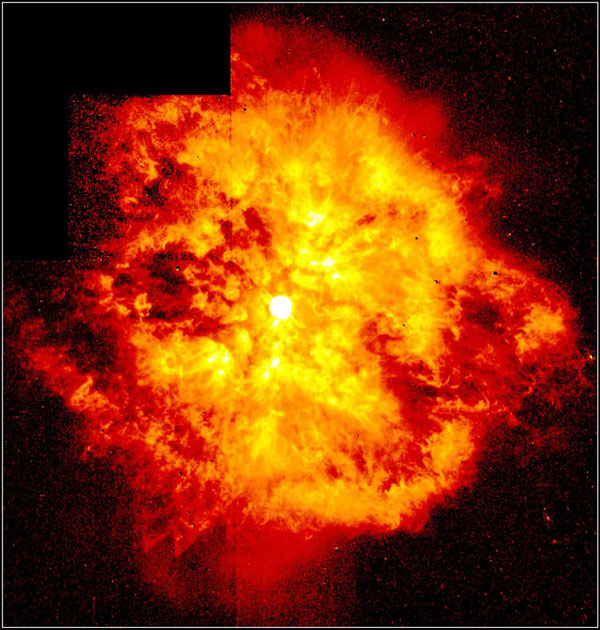 The Harvard Spectral Classification is based on the absorption lines (i.e. bark lines) in the stellar spectrum, that are sensitive to the stellar temperature, rather than to gravity or luminosity. The important lines are H-lines, ionized He, neutral He, weak / medium / strong ionized Ca and weak / strong
The Harvard Spectral Classification is based on the absorption lines (i.e. bark lines) in the stellar spectrum, that are sensitive to the stellar temperature, rather than to gravity or luminosity. The important lines are H-lines, ionized He, neutral He, weak / medium / strong ionized Ca and weak / strong There are seven classes of stars according to this classification
The surface temperature decreases as we move from O star to M star. Similarly, the mass and radius of the star decreases from O type to M type. These spectral classes are further divided into sub classes denoted by the number 0 to 9. The main characteristic of the different classes on Harvard Spectral Classification are as follows:
O star: Blue star, surface temperature > 25,000K, Strong line ionized He (also CIII, NIII, OIII, SIV, HeI visible), H line is weak
B star: Blue white stars, surface temperature 11,000 K to 25,000 K, strongest line is neutral He (HeI) – 403 nm (ionized He lines i.e. HeII have disappeared), HI lines getting stronger (CaII, OII, SiII, MgII lines visible). Example: Rigel
A star: White star, surface temperature 7500 K – 11,000 K, strongest line is HI (HeI no longer visible), weak CaII (ionized calcium) appears, neutral metal lines begin to appear.
F star: Yellow white stars, surface temperature 6000 K – 7500 K, strongest line CaII getting stronger, HI lines getting weaker, Metal line getting stronger (FeI, FeII, CrII, TiII)
G star: Yellow star (Sun), surface temperature 5000 K – 6000 K, strongest line is CaII getting stronger and stronger, HI line still appears but getting weaker, metal lines getting stronger, CN line seen in giants.
K star: Orange yellow stars, surface temperature 3500 K – 5000 K, strongest line is CaII, HI line very weak, CaI (neutral calcium) clearly visible, becomes visible, many metal lines
M star: Red stars, surface temperature < 3500 K, strongest line is CaI, TiO getting stronger, many neutral metal lines seen.
This is the basic Harvard Spectral Classification and are mainly due to different effective temperatures. Different pressures and chemical compositions of stellar atmospheres are not very important factors in the spectral classifications.
Harvard spectral classification of the star
| Class | M x Mo | R x Ro | L x Lo | T (x 10^3 K) | H – Lines | Other spectra | Examples |
|---|---|---|---|---|---|---|---|
| O | 60 | 15 | 1,400,000 | > 25 | weak | He II | 10 Lacertra |
| B | 18 | 7 | 20,000 | 11 – 25 | medium | neutral He I | Rigal |
| A | 3.2 | 2.5 | 80 | 7.5 – 11 | strong | weak Ca II | Sirius |
| F | 1.7 | 1.3 | 6 | 6 – 7.5 | medium | weak Ca II | Canopus |
| G | 1.1 | 1.1 | 1.2 | 5 – 6 | weak | Medium Ca II | Sun |
| K | 0.8 | 0.9 | 0.4 | 3.5 – 5 | very weak | Strong Ca II | Arcturus |
| M | 0.3 | 0.4 | 0.04 | < 3.5 | very weak | Strong |
Betelgeuse |
Here Mo is the mass of the sun, Ro is the radius of the sun and Lo is the luminosity of the Sun.






